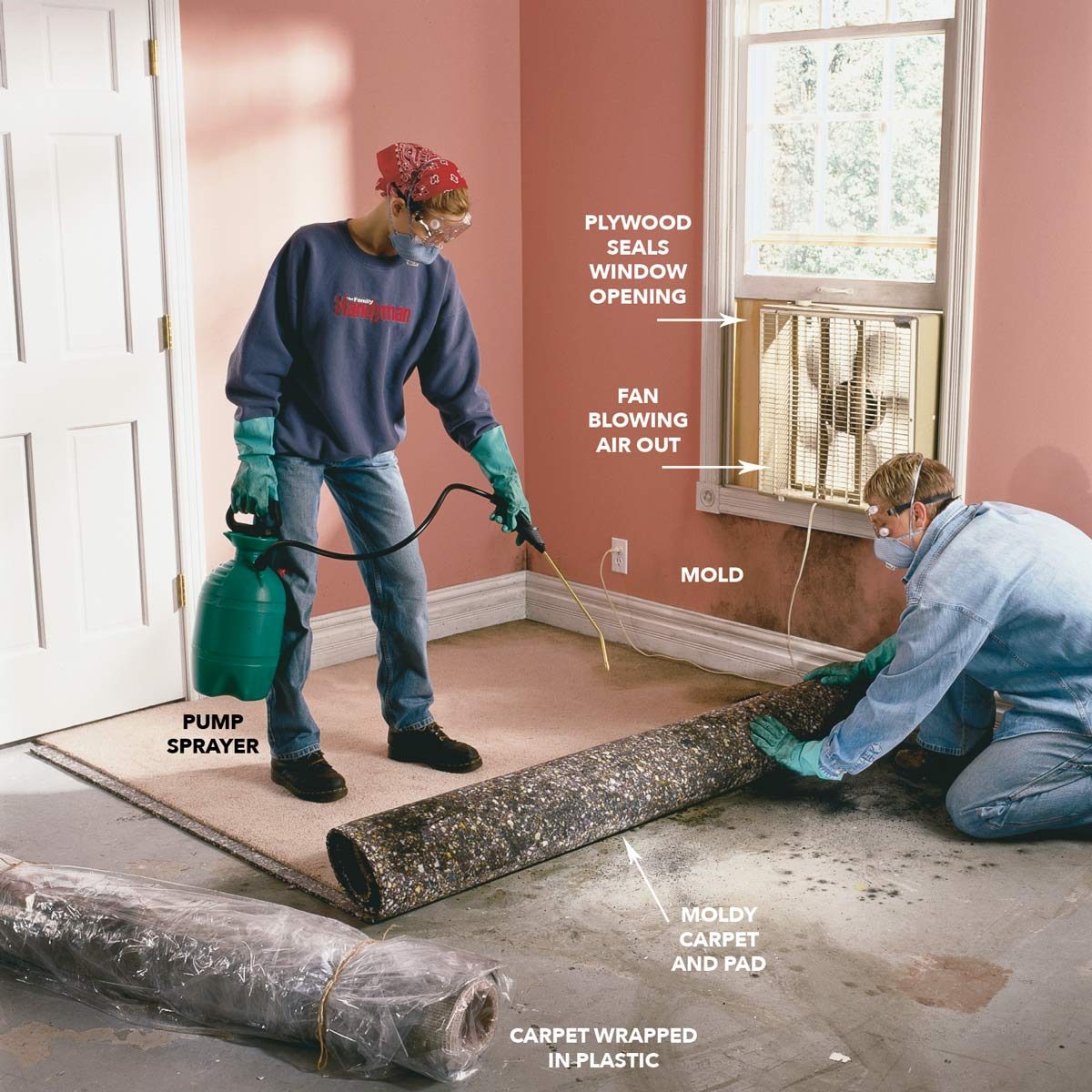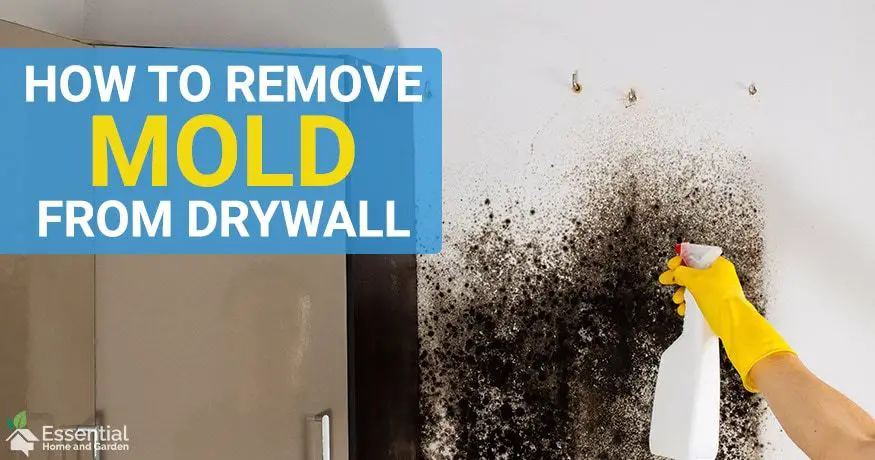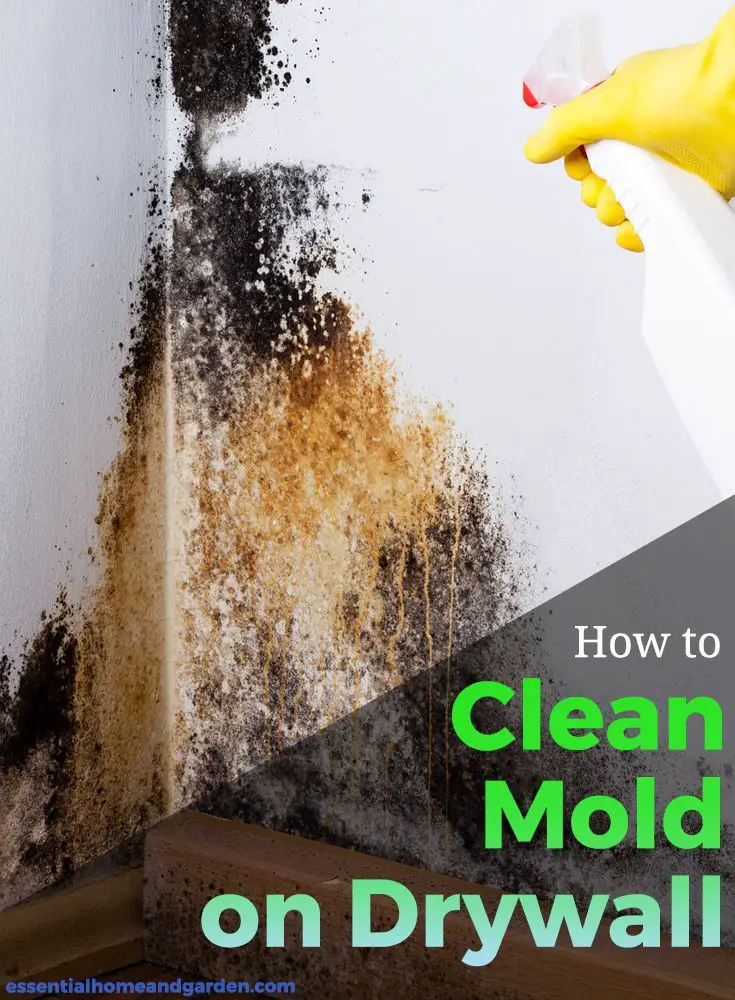What Causes Mold On Drywall
Before removing mold from drywall, it would be best first to find out what caused it. The most common culprits are excessive indoor humidity levels, which is an easy fix or a leak/unseen water damage, most often originating from behind the wall or from above in the ceiling. If you suspect a water leak use a moisture meter to check behind the wall of the affected area.
Only after first taking care of the cause can you safely start the cleaning process without having to worry about whether or not the problem will return.
How To Remove Mold From Inside Walls
The inside of your walls is a great environment for mold, but a terrible one for you to find and clean. Often homeowners dont realize there is mold inside their walls until its causing a major problem. Warning signs include an earthy, musty odor in the home, allergy symptoms that clear up when you leave the property, and stains or dampness on the wall itself. If mold does get inside your walls, youll probably need a pro to handle it. At the very least, the drywall has to come down in order to properly access and treat the mold and prevent it from coming back. You can mitigate the damage by looking out for the warning signs, and reducing the humidity in your property.
Identify The Mold Affected Surfaces
Keep in mind, that treating all of your mold growth at once will help to ensure that the mold doesnt begin to spread again once youre finished. Because If you have mold in one place, theres a good chance you have it someplace else.
For this step, place a small piece of painters tape near but not on, each mold spot you locate. This will help you quickly identify them later when your removing mold in your house.
If your mold problems are on the Outside of your house See our article on the Best Vinyl Siding Cleaner you can buy.
Read Also: How To Get Mold Off Shower Grout
Benefits Of Hiring Professional Mold Remediators
- They discover all of the mold in your place visible and hidden mold
- They have the proper equipment to remove all of the mold and mold spores in a speedy and efficient manner.
- They can find and eliminate the source of mold even in porous materials.
- They can make sure the future growth of mold is prevented.
- They repair any damage and thoroughly clean the contaminated space.
- They are quick and efficient they can also save you time and money but making sure all of the mold is removed the first time
If you have mold in your home and dont want to take the time to try and do it yourself or simply want to make sure it is done correctly the first time, give Home Healthy Homes a call for your mold remediation needs.
Ammonia Can Kill Mold As Well

Ammonia should be considered an option of last resort if the mold is on your drywall.
It is a rather toxic chemical and it doesnt absorb into the drywall very well.
Never use ammonia on a wall that youve already cleaned with bleach because the combination of these two chemicals creates a gas that is toxic.
Always use clear ammonia if this is the method that you prefer.
Read Also: Basement Mold Removal Diy
How To Remove Mold On Drywall
If you notice mold on a drywall surface in your home, try not to panic. The truth is that mold can happen anywhere and in any home. All it needs to grow is a source of moisture and an organic food source, and drywall can be an all-you-can-eat buffet. Read these steps on how to safely remove mold from your drywall.
Mold spores are everywhere. They float through the air and can settle on any surface. If that surface is damp and theres a food source present, mold will grow.
The paper face on a damp sheet of drywall can be the perfect food source for a spore to dig into. Before long, the mold can multiply and spread across the entire wall and into the wall cavity, feeding on wood framing and flooring.
While its hard not to panic at the thought of a mold problem, you can handle most drywall mold scenarios on your own. According to the EPA, homeowners can remove mold on drywall under 10 square feet. Larger infestations might require a pro.
Is Black Mold The Only Dangerous Mold
The simple answer is yes, mold can be dangerous, but not all molds are as dangerous as others. One of the most dangerous forms of mold is black mold, and it is also one of the worst. Another common mold in homes and apartments is white mold, and white mold is generally not that dangerous. In general, however, all molds should be considered dangerous and caution should be exercised when removing them, thus limiting the risk of mold exposure and its associated harmful side effects.
Also Check: Remove Mold From Carpeting
How To Get Rid Of Mold On Bathroom Walls
Bathroom mold is an unsightly and unhealthy problem that should be addressed as soon as you spot it. For mold on painted walls, try a natural remover. Learn more here.
Bathroom mold is an unsightly and unhealthy problem that should be addressed as soon as you spot it. The most common places to find mold are tile grout, caulk and painted or wallpapered walls.
Bathroom mold occurs primarily because mold loves damp, dark, isolated spaces, says Larry Vetter of Vetter Environmental Services in Smithtown, N.Y. Typically, a bathtub, shower, or entire bathroom remains damp enough for mold growth just from showering or bathing.
Chances are, if youre reading this, you already have a mold problem in your bathroom. In that case, there are some simple steps you can take to get rid of that mold.
Use A Bleach/water Combination
Using a mixture of 0.5 cup bleach to 1 quart water, take a scrub brush and lightly brush the drywall until all of the signs of mold disappear.
Youll want to wipe off the surface once it has disappeared, but make sure you dont rinse the surface. By leaving the bleach on, youll be able to kill the spores which may be in the drywall.
Expose the drywall to sunlight if at all possible.
Also Check: How To Clean Mold Off Plastic Cutting Board
Does Vinegar Kill Black Mold
Vinegar can kill up to 80% of mold varieties, including Stachybotrys chartarum, or black mold. For greater effectiveness, consider mixing together a solution of vinegar, water and a powder-based antifungal or abrasive cleaner, such as Borax or baking soda, both of which are sold at grocery and home improvement stores.
How To Effective Remove Mold In Your Home Or Business
There are several products that can be utilized to kill and remove mold. Some effective products that kill mold are:
- Bleach
- Tea tree oil
- Grapefruit seed extract
While these types of products can be effective in killing mold, they are only efficient when you recognize the first signs of mold growth and manage to prevent its development. In addition to eliminating the mold you see, you must also eliminate the source of the moisture that allowed its appearance in the first place. For many people, while doing it yourself may be an option to remove the mold it is often done incompletely providing only a temporary solution to your mold problem.
It is always best to hire a professional mold remediation company when you see mold but, if the mold in your home is not toxic and the area of mold growth is small then you can try to perform the mold remediation on your own.
Read Also: How To Clean Mold Off Bathroom Ceiling
Household Cleaning Solutions Are Affordable
Whether you prefer to use standard 5% strength distilled white vinegar, 6% cleaning vinegar, baking soda, Borax or hydrogen peroxide, all of these cleaning solutions are affordable and likely to be in your home already. These ingredients are also available for sale at most grocery and home improvement stores.
If mold is growing on a non-porous surface, you can use a surface disinfectant like bleach or vinegar. While the costs may be comparable, the effects of cleaning walls with these solutions may result in a need to repaint or refinish walls sooner rather than later.
Stubborn mold infestations may call for the use of heavy-duty fungicides or mildewcides. Make sure to use mold killing products that are for the intended application. If you are not sure about the extent of an infestation or whether the mold is toxigenic, consider contacting certified mold removal professionals to inspect or test mold and recommend the most effective approach to remediation.
How To Get Rid Of Mold In Attics

Attics are prone to mold either because of leaks from roofs or window seals, or because poor ventilation is allowing condensation to build up. Therefore treating those problems is always the most important step you can take to avoid getting mold in your attic, or to prevent it from coming back. Once youre sure your attic is watertight and ventilated, discard any stored items that are contaminated, or remove them for cleaning and restoration. Seal off the attic during cleaning and use a wet vacuum to clean as much visible mold as possible. Treat walls, floor, and exposed timbers with a mold removal spray to kill mold quickly and effectively, and install a fan or dehumidifier to dry the attic once the treatment is complete.
Also Check: Clean Mold Off Bathroom Ceiling
Baking Soda And Borax For Killing Mold
For stubborn stains, mix two parts Baking Soda with one part vinegar and one part water. Spread the thick mixture on a moldy area and let it dry.
Gently scrub the mixture, rinse, or wipe clean and repeat if necessary. This method works well on ceilings, where a liquid may drip off onto the floor or into your eyes.
Borax is also another powder-form chemical that can be used to get rid of mold.
Mix one part borax to 16 parts water, or one cup to a gallon of water for spray applications.
Use a thicker mixture on surfaces where you dont want to use much water, such as drywall or hard-to-dry fabrics.
How To Remove Mold On Painted Drywall
If you find mold on drywall that is painted, its much easier to clean. Since paint provides a barrier on the drywall, the mold most likely hasnt penetrated the surface, meaning you just need a good cleaner and some elbow grease.
Before you start, make sure you identify the source of moisture causing the mold in the first place and fix the issue. Then, follow these steps to remove mold on painted drywall.
Recommended Reading: What Causes Mold On Ceilings
In The Rest Of Your Home
Inspect your interior hoses. You should replace flexible hoses on washing machines and kitchen sink sprayers immediately if you see a leak or condensation, and every five years, even if you dont spot problems. If you dont replace them on time, your homeowners or renters insurance wont pay if they burst and cause water damage. Inspect your roof after storms. Look for loose shingles or other damage that could allow water to enter your attic or home. Keep your foundation clear. Dont stack firewood or other items against your homes foundation, or youll encourage water collection there that will seep into your basement walls.
Fix cracks promptly. Whether you find cracks in your foundation or siding, fix them immediately to keep water out of your home. Clean your gutters in the Spring and Fall. Clogged gutters lead to water pooling near your foundation or along your walls, and that leads to water damage that causes mold.
Remember, mold wont go away on its own. If you find signs of it growing on your walls, you need to take prompt action to get rid of it with these easy homemade mold-killing sprays. Then keep it from coming back by controlling your homes humidity levels, promoting good air circulation, and regularly cleaning to remove mold spores.
Where to Next?
Should You Repair Or Replace Mold Infested Drywall
Your home’s drywall is an important part of its structure, and it need to always be kept in great condition. If your drywall is damaged in any way, it needs to be repaired as soon as possible so that your home can be kept in great shape at all times. When any part of your home’s drywall is infested with mold, you need to take care of the problem immediately, or the mold could spread across more of your home, and it could cause serious medical problems for any members of your household.
At Litehouse Painting, our professional Miami Valley painters can provide you with repairs and replacements any part of your drywall that is damaged. Many homeowners attempt to simply repair drywall that is infested with mold, but it should always be fully replaced. If you don’t replace every part of your drywall that has experienced mold growth, you’re only leaving your home vulnerable to much more damage in the future.
Read Also: How Quickly Can Mold Grow
C What Can You Use To Kill Mold On Drywall
Several mold cleaning agents can be used to kill this annoying organism. In addition to mold removal products, you can use some other alternatives in either natural or chemical substances.
Natural solutions are useful for treating light mold infestation. Meanwhile, if your drywall has been infected by a heavy dose of mold, removal product containing strong chemical substances are more advisable.
Regarding natural solutions, vinegar and baking soda have been known as an effective cleaning agent to get rid of mold. Those substances are safe to use, even in a home environment with children and pets. You can mix them both with water or separate them in a different solution.
Other cleaning agents that are not less effective are borax, detergents, bleach, and hydrogen peroxide. Alternatively, if you are looking for practical mold killing agents, you can purchase some products of mold control spray which are largely available in the market.
Besides using the cleaning agents or solutions, mold on drywall can be removed by using High-Efficiency Particular Air Vacuum . During the cleaning process, mold spores are often released into the air and fly around the surrounding area.
This tool will come in handy when you have to deal with such a situation. However, if the HEPA Vacuum is hard to get, you can always use the regular one, though it is considered less effective.
Coated Or Painted Drywall
Don’t Miss: How To Clean Mold Off Bathroom Ceiling
How To Remove Mold On Cement Or Removing Mold From Painted Walls
Remove Mold on Cement. Source: Unsplash.com
Applying the following methods, your cement will not be moldy anymore:
Dilute bleach water, when the sun is up, use a hard brush to sweep the cement surface with this diluted bleach water to clean the mold. Or, you can use liquid lime to scan the moldy areas, wait a few hours for the lime to dry, then peel off the dry lime layers to remove the mold. Removing mold from walls with vinegar is also a good choice you should consider.
The last way is using chemicals the mandatory measure in case the above methods do not work. However, chemicals contain toxic and hazardous herbicides content, so you should consider before using it removing mold from walls and ceiling.
You can find out more about How-to-clean guide via these posts about:
Hiring A Mold Removal Expert

The EPA advises that if you have significant mold on the walls of your home, you should hire an expert to remove it. However, they state that you must ensure the contractor is certified, insured and trained specifically in mold remediation.
Mold removal professionals will follow a remediation procedure. Typically, theyll start by identifying the mold by collecting samples and testing it. They will then assess the extent of your issue and create a plan to completely remove mold from your property.
Next, theyll begin the mold removal process. Finally, they will carry out tests and issue a clearance report.
Also Check: Remove Mildew From Bathroom Ceiling
